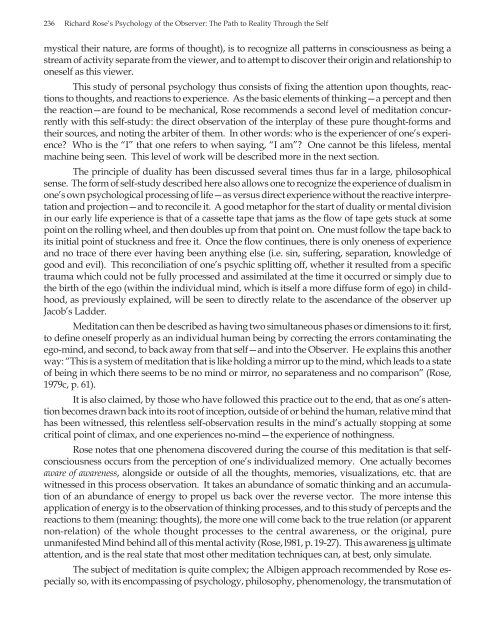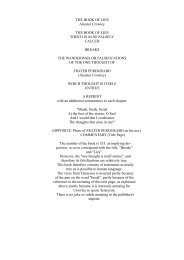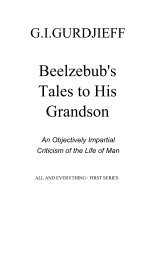Richard Rose’s Psychology of the Observer The Path to Reality Through the Self
John-Kent-Richard-Rose's-Psychology-of-Observer-Path-to-Reality-Thru-the-Self
John-Kent-Richard-Rose's-Psychology-of-Observer-Path-to-Reality-Thru-the-Self
Create successful ePaper yourself
Turn your PDF publications into a flip-book with our unique Google optimized e-Paper software.
236 <strong>Richard</strong> <strong>Rose’s</strong> <strong>Psychology</strong> <strong>of</strong> <strong>the</strong> <strong>Observer</strong>: <strong>The</strong> <strong>Path</strong> <strong>to</strong> <strong>Reality</strong> <strong>Through</strong> <strong>the</strong> <strong>Self</strong><br />
mystical <strong>the</strong>ir nature, are forms <strong>of</strong> thought), is <strong>to</strong> recognize all patterns in consciousness as being a<br />
stream <strong>of</strong> activity separate from <strong>the</strong> viewer, and <strong>to</strong> attempt <strong>to</strong> discover <strong>the</strong>ir origin and relationship <strong>to</strong><br />
oneself as this viewer.<br />
This study <strong>of</strong> personal psychology thus consists <strong>of</strong> fixing <strong>the</strong> attention upon thoughts, reactions<br />
<strong>to</strong> thoughts, and reactions <strong>to</strong> experience. As <strong>the</strong> basic elements <strong>of</strong> thinking—a percept and <strong>the</strong>n<br />
<strong>the</strong> reaction—are found <strong>to</strong> be mechanical, Rose recommends a second level <strong>of</strong> meditation concurrently<br />
with this self-study: <strong>the</strong> direct observation <strong>of</strong> <strong>the</strong> interplay <strong>of</strong> <strong>the</strong>se pure thought-forms and<br />
<strong>the</strong>ir sources, and noting <strong>the</strong> arbiter <strong>of</strong> <strong>the</strong>m. In o<strong>the</strong>r words: who is <strong>the</strong> experiencer <strong>of</strong> one’s experience?<br />
Who is <strong>the</strong> “I” that one refers <strong>to</strong> when saying, “I am”? One cannot be this lifeless, mental<br />
machine being seen. This level <strong>of</strong> work will be described more in <strong>the</strong> next section.<br />
<strong>The</strong> principle <strong>of</strong> duality has been discussed several times thus far in a large, philosophical<br />
sense. <strong>The</strong> form <strong>of</strong> self-study described here also allows one <strong>to</strong> recognize <strong>the</strong> experience <strong>of</strong> dualism in<br />
one’s own psychological processing <strong>of</strong> life—as versus direct experience without <strong>the</strong> reactive interpretation<br />
and projection—and <strong>to</strong> reconcile it. A good metaphor for <strong>the</strong> start <strong>of</strong> duality or mental division<br />
in our early life experience is that <strong>of</strong> a cassette tape that jams as <strong>the</strong> flow <strong>of</strong> tape gets stuck at some<br />
point on <strong>the</strong> rolling wheel, and <strong>the</strong>n doubles up from that point on. One must follow <strong>the</strong> tape back <strong>to</strong><br />
its initial point <strong>of</strong> stuckness and free it. Once <strong>the</strong> flow continues, <strong>the</strong>re is only oneness <strong>of</strong> experience<br />
and no trace <strong>of</strong> <strong>the</strong>re ever having been anything else (i.e. sin, suffering, separation, knowledge <strong>of</strong><br />
good and evil). This reconciliation <strong>of</strong> one’s psychic splitting <strong>of</strong>f, whe<strong>the</strong>r it resulted from a specific<br />
trauma which could not be fully processed and assimilated at <strong>the</strong> time it occurred or simply due <strong>to</strong><br />
<strong>the</strong> birth <strong>of</strong> <strong>the</strong> ego (within <strong>the</strong> individual mind, which is itself a more diffuse form <strong>of</strong> ego) in childhood,<br />
as previously explained, will be seen <strong>to</strong> directly relate <strong>to</strong> <strong>the</strong> ascendance <strong>of</strong> <strong>the</strong> observer up<br />
Jacob’s Ladder.<br />
Meditation can <strong>the</strong>n be described as having two simultaneous phases or dimensions <strong>to</strong> it: first,<br />
<strong>to</strong> define oneself properly as an individual human being by correcting <strong>the</strong> errors contaminating <strong>the</strong><br />
ego-mind, and second, <strong>to</strong> back away from that self—and in<strong>to</strong> <strong>the</strong> <strong>Observer</strong>. He explains this ano<strong>the</strong>r<br />
way: “This is a system <strong>of</strong> meditation that is like holding a mirror up <strong>to</strong> <strong>the</strong> mind, which leads <strong>to</strong> a state<br />
<strong>of</strong> being in which <strong>the</strong>re seems <strong>to</strong> be no mind or mirror, no separateness and no comparison” (Rose,<br />
1979c, p. 61).<br />
It is also claimed, by those who have followed this practice out <strong>to</strong> <strong>the</strong> end, that as one’s attention<br />
becomes drawn back in<strong>to</strong> its root <strong>of</strong> inception, outside <strong>of</strong> or behind <strong>the</strong> human, relative mind that<br />
has been witnessed, this relentless self-observation results in <strong>the</strong> mind’s actually s<strong>to</strong>pping at some<br />
critical point <strong>of</strong> climax, and one experiences no-mind—<strong>the</strong> experience <strong>of</strong> nothingness.<br />
Rose notes that one phenomena discovered during <strong>the</strong> course <strong>of</strong> this meditation is that selfconsciousness<br />
occurs from <strong>the</strong> perception <strong>of</strong> one’s individualized memory. One actually becomes<br />
aware <strong>of</strong> awareness, alongside or outside <strong>of</strong> all <strong>the</strong> thoughts, memories, visualizations, etc. that are<br />
witnessed in this process observation. It takes an abundance <strong>of</strong> somatic thinking and an accumulation<br />
<strong>of</strong> an abundance <strong>of</strong> energy <strong>to</strong> propel us back over <strong>the</strong> reverse vec<strong>to</strong>r. <strong>The</strong> more intense this<br />
application <strong>of</strong> energy is <strong>to</strong> <strong>the</strong> observation <strong>of</strong> thinking processes, and <strong>to</strong> this study <strong>of</strong> percepts and <strong>the</strong><br />
reactions <strong>to</strong> <strong>the</strong>m (meaning: thoughts), <strong>the</strong> more one will come back <strong>to</strong> <strong>the</strong> true relation (or apparent<br />
non-relation) <strong>of</strong> <strong>the</strong> whole thought processes <strong>to</strong> <strong>the</strong> central awareness, or <strong>the</strong> original, pure<br />
unmanifested Mind behind all <strong>of</strong> this mental activity (Rose, l981, p. 19-27). This awareness is ultimate<br />
attention, and is <strong>the</strong> real state that most o<strong>the</strong>r meditation techniques can, at best, only simulate.<br />
<strong>The</strong> subject <strong>of</strong> meditation is quite complex; <strong>the</strong> Albigen approach recommended by Rose especially<br />
so, with its encompassing <strong>of</strong> psychology, philosophy, phenomenology, <strong>the</strong> transmutation <strong>of</strong>




